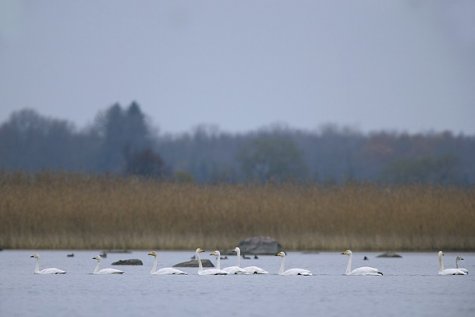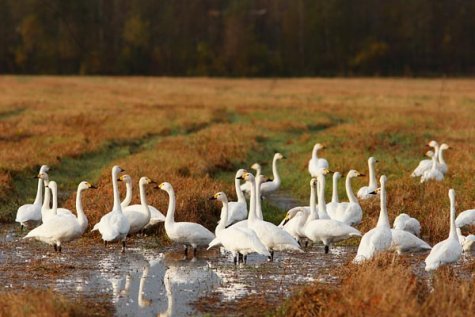Snow gone, swans still here ...
Photos: Arne Ader and Kaarel Kaisel
Translation: Liis
Whooper and Bewick’s swans. Matsalu bay
Bewick's swan Väikeluik Cygnus columbianus
Whooper swan Laululuik Cygnus cygnus
On average the swans that breed on the tundra reach Estonia on their migration in mid-October – so it is this year too. They leave with the month of November; of course some stay to spend winter here, depending on the ice conditions but they are few. Stopping places on the migration are Matsalu bay, Haapsalu bay, Silma nature protection area, Väike sound, Käina bay, Audru polder, Pärnu bay and the Kallaste-Mustvee shore at Lake Peipsi, Lake Lahepera ...
On the autumn migration the Bewick’s swans are more numerous than the whooper swans: more than twenty thousand and up to ten thousand birds respectively. Whooper swans fly very high up at migration, over eight kilometres has been registered; air temperature there is – 40 degrees. Flight view is a straight line, with slow and heavy wingbeats, and the low-pitched swoosh is audible from far away. They need a long runway both for landing and for takeoff. The call of whooper swans is a loud and far-reaching honking. We always see whooper swans in groups in waters, swimming or standing in the water. Whooper swans are roughly the same size as mute swans, with a straight neck and a slim silhouette. The beak base of adults is broadly yellow, the tip black; the base of the beak of young birds is pinkish and the plumage brownish grey. Whooper swans don’t bend their neck neither do they ruffle the wings as mute swans do.
And now about the smaller relatives that arrive here later – the Bewick’s swans. Until departure they often move and feed together with whooper swans in our waters. Studying a mixed flock we note that we have to do with a somewhat smaller bird than the whooper swan. There is less yellow on the beak base; the beak seems black from a distance.
They feed on aquatic plants that they grasp even at a depth of sixty centimetres. When food becomes scarce in natural waters they move to wet or damp grain fields to feed from the seed sprouts or spilled grain – they prefer barley, wheat and oats.
On the grain fields of Matsalu Bewick’s swans were first seen in 1978. In the wintering areas in the Netherlands and Germany sugar beet and potato fields are preferred.
Bewick’s swans autumn migration goes in two waves – first the young birds move, in the second the adults with the juveniles from this year.
Bewick's swans










